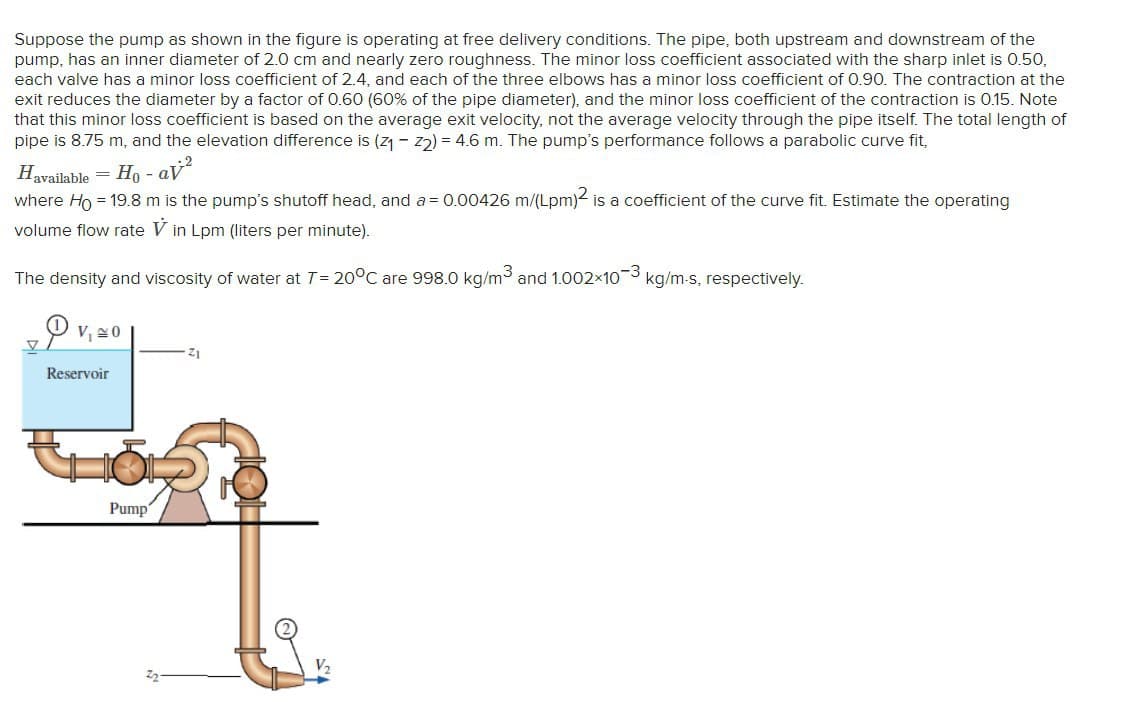Suppose the pump as shown in the figure is operating at free delivery conditions. The pipe, both upstream and downstream of the pump, has an inner diameter of 2.0 cm and nearly zero roughness. The minor loss coefficient associated with the sharp inlet is 0.50, each valve has a minor loss coefficient of 2.4, and each of the three elbows has a minor loss coefficient of 0.90. The contraction at the exit reduces the diameter by a factor of 0.60 (60% of the pipe diameter), and the minor loss coefficient of the contraction is 0.15. Note that this minor loss coefficient is based on the average exit velocity, not the average velocity through the pipe itself. The total length of pipe is 8.75 m, and the elevation difference is (z1 - z) = 4.6 m. The pump's performance follows a parabolic curve fit, Havailable = H, - aV where Ho = 19.8 m is the pump's shutoff head, and a = 0.00426 m/(Lpm)2 is a coefficient of the curve fit. Estimate the operating volume flow rate V in Lpm (liters per minute). The density and viscosity of water at T= 20°C are 998.0 kg/m3 and 1.002x103 kg/m-s, respectively. V, 20 Z1 Reservoir Pump V2
Suppose the pump as shown in the figure is operating at free delivery conditions. The pipe, both upstream and downstream of the pump, has an inner diameter of 2.0 cm and nearly zero roughness. The minor loss coefficient associated with the sharp inlet is 0.50, each valve has a minor loss coefficient of 2.4, and each of the three elbows has a minor loss coefficient of 0.90. The contraction at the exit reduces the diameter by a factor of 0.60 (60% of the pipe diameter), and the minor loss coefficient of the contraction is 0.15. Note that this minor loss coefficient is based on the average exit velocity, not the average velocity through the pipe itself. The total length of pipe is 8.75 m, and the elevation difference is (z1 - z) = 4.6 m. The pump's performance follows a parabolic curve fit, Havailable = H, - aV where Ho = 19.8 m is the pump's shutoff head, and a = 0.00426 m/(Lpm)2 is a coefficient of the curve fit. Estimate the operating volume flow rate V in Lpm (liters per minute). The density and viscosity of water at T= 20°C are 998.0 kg/m3 and 1.002x103 kg/m-s, respectively. V, 20 Z1 Reservoir Pump V2
Elements Of Electromagnetics
7th Edition
ISBN:9780190698614
Author:Sadiku, Matthew N. O.
Publisher:Sadiku, Matthew N. O.
ChapterMA: Math Assessment
Section: Chapter Questions
Problem 1.1MA
Related questions
Question

Transcribed Image Text:Suppose the pump as shown in the figure is operating at free delivery conditions. The pipe, both upstream and downstream of the
pump, has an inner diameter of 2.0 cm and nearly zero roughness. The minor loss coefficient associated with the sharp inlet is 0.50,
each valve has a minor loss coefficient of 2.4, and each of the three elbows has a minor loss coefficient of 0.90. The contraction at the
exit reduces the diameter by a factor of 0.60 (60% of the pipe diameter), and the minor loss coefficient of the contraction is 0.15. Note
that this minor loss coefficient is based on the average exit velocity, not the average velocity through the pipe itself. The total length of
pipe is 8.75 m, and the elevation difference is (z1 - z) = 4.6 m. The pump's performance follows a parabolic curve fit,
Havailable = H, - aV
where Ho = 19.8 m is the pump's shutoff head, and a = 0.00426 m/(Lpm)2 is a coefficient of the curve fit. Estimate the operating
volume flow rate V in Lpm (liters per minute).
The density and viscosity of water at T= 20°C are 998.0 kg/m3
and 1.002x103 kg/m-s, respectively.
V,20
Z1
Reservoir
Pump
Expert Solution
This question has been solved!
Explore an expertly crafted, step-by-step solution for a thorough understanding of key concepts.
This is a popular solution!
Trending now
This is a popular solution!
Step by step
Solved in 5 steps with 5 images

Knowledge Booster
Learn more about
Need a deep-dive on the concept behind this application? Look no further. Learn more about this topic, mechanical-engineering and related others by exploring similar questions and additional content below.Recommended textbooks for you

Elements Of Electromagnetics
Mechanical Engineering
ISBN:
9780190698614
Author:
Sadiku, Matthew N. O.
Publisher:
Oxford University Press

Mechanics of Materials (10th Edition)
Mechanical Engineering
ISBN:
9780134319650
Author:
Russell C. Hibbeler
Publisher:
PEARSON

Thermodynamics: An Engineering Approach
Mechanical Engineering
ISBN:
9781259822674
Author:
Yunus A. Cengel Dr., Michael A. Boles
Publisher:
McGraw-Hill Education

Elements Of Electromagnetics
Mechanical Engineering
ISBN:
9780190698614
Author:
Sadiku, Matthew N. O.
Publisher:
Oxford University Press

Mechanics of Materials (10th Edition)
Mechanical Engineering
ISBN:
9780134319650
Author:
Russell C. Hibbeler
Publisher:
PEARSON

Thermodynamics: An Engineering Approach
Mechanical Engineering
ISBN:
9781259822674
Author:
Yunus A. Cengel Dr., Michael A. Boles
Publisher:
McGraw-Hill Education

Control Systems Engineering
Mechanical Engineering
ISBN:
9781118170519
Author:
Norman S. Nise
Publisher:
WILEY

Mechanics of Materials (MindTap Course List)
Mechanical Engineering
ISBN:
9781337093347
Author:
Barry J. Goodno, James M. Gere
Publisher:
Cengage Learning

Engineering Mechanics: Statics
Mechanical Engineering
ISBN:
9781118807330
Author:
James L. Meriam, L. G. Kraige, J. N. Bolton
Publisher:
WILEY